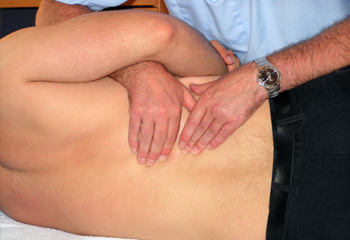Manipulation
Osteopaths, chiropractors and manipulative therapists all perform treatment on the muscles and bones of the body. In particular, these practitioners place emphasis on the spine and most treatments will focus on ensuring full mobility of the spine. This usually entails ‘manipulation’ when the two opposing surfaces of a spinal joint are ‘opened’ up to break down adhesions.
Full manipulation of a joint, usually, only takes place after work has been carried out to rebalance the muscles that support the joint. For example, a patient with neck problems, who might benefit from manipulation, would normally undergo soft tissue work, exercise routines and mobilisation before manipulation. This enables the muscles and ligaments that support the joint to regain tone and balance before full manipulation is attempted. This gradual process allows the body to adapt at its own pace and over the years I have found it to be the most successful method of treating spinal imbalances.
I may also use a combination of other techniques, for example; soft tissue work - relaxing muscle tension; increasing joint mobility, circulation, lymphatic and venous drainage; improving organ function and the absorption of nutrients; improving the secretion and transport of enzymes and hormones.
Neuromuscular techniques - using a variety of pressure and stretch techniques in order to restore muscle balance and tone. It aims to improve drainage of blood and lymph and to reduce fatty deposits, especially cellulite.
Muscle energy techniques - methods of treating shortened or tightened muscles.
Mobilisation of joints - encouraging joints to regain optimal movement by gentle, passive, stretching of the joints, with minimum pain.
Postural homework - patients may be encouraged to alter their posture, diet and lifestyle, in ways that will improve their future health.
